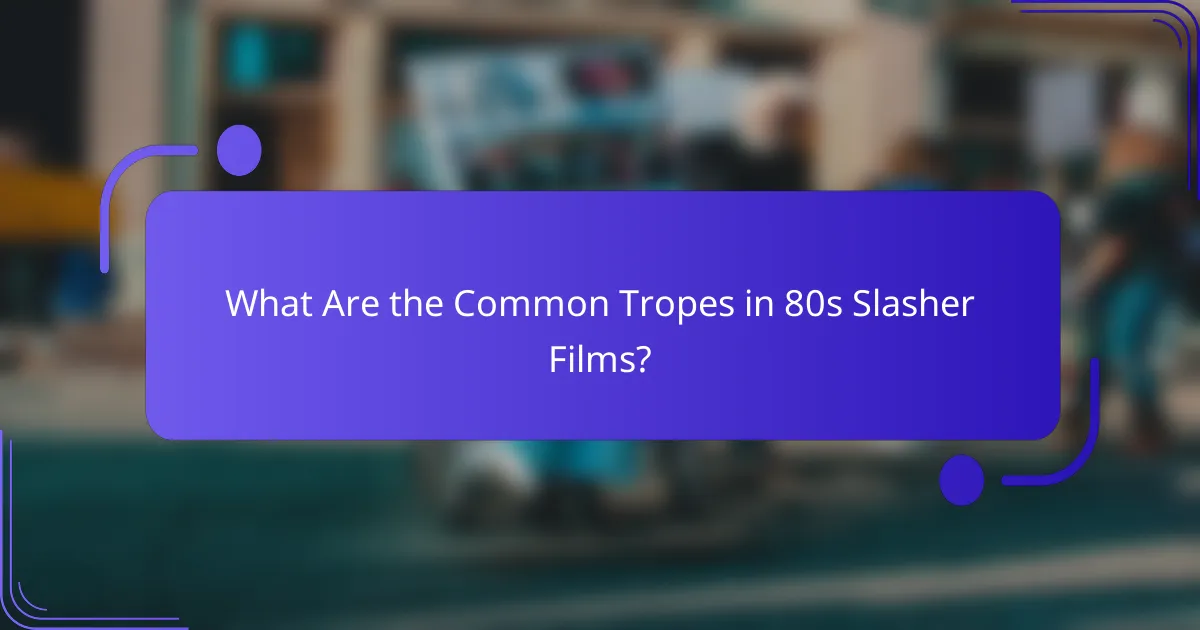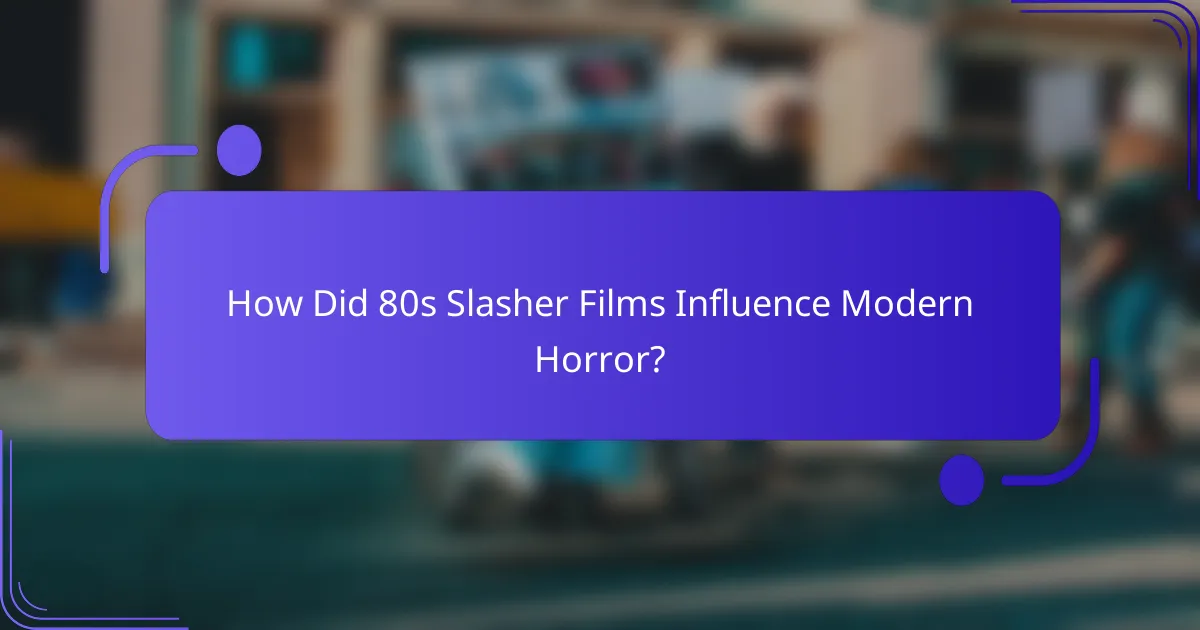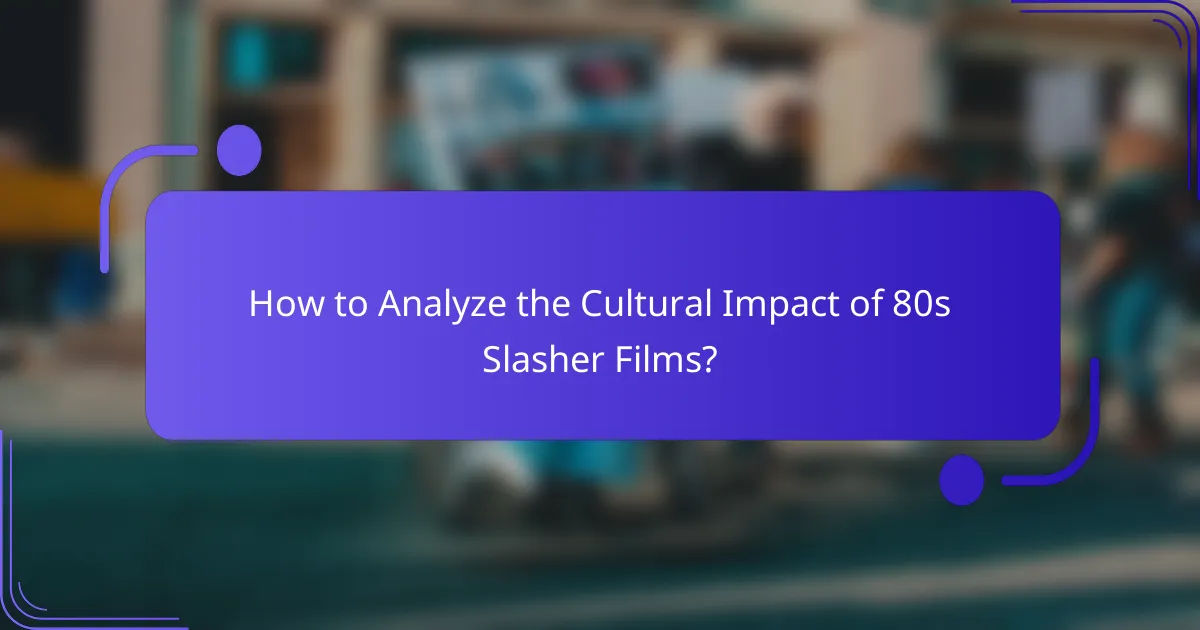The 80s slasher film genre is characterized by its common tropes, iconic characters, and the emergence of the Final Girl. These films often feature recurring themes and archetypes that heighten suspense and horror, leaving a lasting impact on audiences. Iconic figures, including masked killers and supernatural entities, have become cultural touchstones, while the Final Girl represents a unique blend of innocence and strength, ultimately confronting the terror that haunts her.

You can learn more in 80s Slasher Films.
What Are the Common Tropes in 80s Slasher Films?
Common tropes in 80s slasher films include recurring themes and character archetypes that define the genre. These elements often contribute to the suspense and horror, making the films memorable and influential in the horror landscape.
The Final Girl Trope
The Final Girl trope refers to the last surviving female character who confronts the killer. This character often embodies innocence and resilience, contrasting with her peers who may engage in reckless behavior. Examples include Laurie Strode from “Halloween” and Nancy Thompson from “A Nightmare on Elm Street.”
This trope highlights themes of survival and empowerment, as the Final Girl typically undergoes a transformation, becoming a fighter rather than a victim. Audiences often root for her, making her eventual confrontation with the antagonist a pivotal moment in the film.
Teenage Party Setting
Many 80s slasher films are set in teenage party environments, such as prom nights or summer camps. These settings create a backdrop for youthful exuberance, which is often interrupted by the arrival of the killer. The juxtaposition of celebration and horror amplifies the tension.
These gatherings serve as a plot device to introduce multiple characters, allowing for various deaths that heighten the stakes. The party atmosphere often leads to poor decision-making, making the characters more vulnerable to the lurking threat.
Masked Killers
Masked killers are a staple of 80s slasher films, adding an element of mystery and fear. Iconic figures like Michael Myers and Jason Voorhees are characterized by their distinctive masks, which conceal their identities and emotions. This anonymity enhances their menacing presence.
The masks often symbolize the killers’ detachment from humanity, making them more terrifying. The visual impact of a masked antagonist creates a lasting impression, contributing to the film’s overall horror aesthetic.
Graphic Violence
Graphic violence is a hallmark of 80s slasher films, often depicted through explicit scenes of murder and gore. This level of violence serves to shock audiences and elicit strong emotional reactions. Films like “Friday the 13th” and “The Texas Chainsaw Massacre” are known for their brutal depictions of death.
While some viewers appreciate the visceral thrill, others criticize it for desensitizing audiences to real-life violence. Filmmakers often balance the gore with suspenseful build-up, ensuring that the violence feels earned within the story.
Isolation Themes
Isolation themes are prevalent in 80s slasher films, often placing characters in remote locations where help is unavailable. This sense of seclusion heightens the fear, as characters realize they cannot escape or call for assistance. Settings like deserted cabins or isolated campuses amplify this feeling.
Isolation not only intensifies the horror but also forces characters to confront their fears and make critical decisions. The absence of outside intervention creates a claustrophobic atmosphere, making the threat of the killer feel even more imminent.
![]()
Who Are the Iconic Characters in 80s Slasher Films?
Iconic characters in 80s slasher films are often defined by their distinctive traits and memorable appearances. These figures, such as masked killers and supernatural entities, have become staples of the genre, influencing countless films and pop culture references.
Michael Myers from Halloween
Michael Myers is one of the most recognizable figures in slasher cinema, first appearing in John Carpenter’s “Halloween” in 1978. His emotionless mask and relentless pursuit of victims establish him as a symbol of pure evil.
Key traits include his near-superhuman strength and ability to survive seemingly fatal injuries. His character embodies the fear of the unknown, making him a chilling presence throughout the franchise.
Freddy Krueger from A Nightmare on Elm Street
Freddy Krueger, introduced in Wes Craven’s “A Nightmare on Elm Street,” is known for invading the dreams of his victims, making him a unique slasher character. His burned face and bladed glove are iconic, symbolizing both horror and dark humor.
Freddy’s ability to manipulate dreams allows for creative and surreal kill sequences, making him a versatile antagonist. His backstory as a child murderer adds depth, turning him into a figure of both fear and fascination.
Jason Voorhees from Friday the 13th
Jason Voorhees is synonymous with the “Friday the 13th” franchise, often depicted wearing a hockey mask and wielding a machete. His character evolves from a vengeful child to an unstoppable killing machine, representing the consequences of neglect and tragedy.
Jason’s relentless pursuit of campers at Crystal Lake highlights themes of survival and the dangers of recklessness. His iconic look and brutal methods have made him a staple in slasher lore.
Chucky from Child’s Play
Chucky, the possessed doll from “Child’s Play,” brings a unique twist to the slasher genre with his small stature and menacing personality. His ability to blend in as a child’s toy adds an unsettling layer to his character.
Chucky’s charm and dark humor contrast with his violent actions, making him both entertaining and terrifying. His character explores themes of innocence corrupted, as he targets children and their families, creating a chilling narrative.

What Defines the Final Girl in 80s Slasher Films?
The Final Girl in 80s slasher films is typically the last surviving female character who confronts the killer. She embodies traits such as innocence, resilience, and resourcefulness, often contrasting with her more reckless peers.
Survivor Archetype
The Final Girl serves as the quintessential survivor archetype, often representing purity and moral integrity. Unlike her friends, she is usually more cautious and less sexually active, which sets her apart as a character who is more likely to endure the horrors of the film.
Examples of iconic Final Girls include Laurie Strode from “Halloween” and Nancy Thompson from “A Nightmare on Elm Street.” These characters not only survive but also often play a pivotal role in defeating the antagonist.
Resourcefulness and Resilience
Resourcefulness and resilience are key traits of the Final Girl, allowing her to navigate dangerous situations effectively. She often uses her intelligence and quick thinking to escape traps set by the killer.
For instance, in “Friday the 13th,” Alice demonstrates her resourcefulness by using her surroundings to fend off Jason. This adaptability is crucial for her survival, showcasing how the Final Girl often relies on her wits rather than brute strength.
Confrontation with the Killer
The Final Girl’s confrontation with the killer is a climactic moment that often defines the film’s resolution. This encounter usually involves a significant transformation, where she shifts from a passive victim to an active fighter.
In many cases, the Final Girl confronts her fears and the killer in a final showdown, symbolizing her growth and empowerment. This moment not only serves as a thrilling climax but also reinforces the theme of survival against overwhelming odds.

How Did 80s Slasher Films Influence Modern Horror?
80s slasher films have significantly shaped modern horror by establishing key tropes and character archetypes that continue to resonate today. Their influence is evident in the way contemporary filmmakers craft suspense and develop characters, often drawing from the established formulas of this iconic genre.
Revival of Slasher Tropes
The revival of slasher tropes in modern horror is marked by a blend of nostalgia and innovation. Filmmakers frequently reference classic elements such as masked killers, isolated settings, and the final girl trope, creating a bridge between past and present. Movies like “Happy Death Day” and “The Cabin in the Woods” cleverly incorporate these conventions while adding fresh twists.
Modern slasher films often play with audience expectations, subverting traditional narratives. For instance, they may introduce self-aware characters who recognize the clichés of the genre, allowing for both homage and critique. This meta-commentary keeps the genre relevant and engaging for new audiences.
You can explore more about these themes in cult horror movie tropes.
Impact on Character Development
Character development in 80s slasher films often centered around archetypes, such as the innocent final girl, the jock, and the promiscuous friend. This simplistic characterization has evolved in modern horror, where characters are given more depth and complexity. Filmmakers now explore backstories and motivations, making characters relatable and their fates more impactful.
The final girl has become a symbol of resilience and empowerment, often portrayed as resourceful and strong. Modern interpretations, such as in “The Final Girls,” challenge the traditional narrative by showcasing the final girl’s journey beyond mere survival, emphasizing her growth and agency. This evolution reflects changing societal attitudes towards gender roles in horror and beyond.

What Are the Key Elements of Slasher Film Soundtracks?
Slasher film soundtracks are crucial for building tension and enhancing the horror experience. Key elements include iconic theme music and the strategic use of silence and sound effects to evoke fear and suspense.
Iconic Theme Music
Iconic theme music often serves as the signature of a slasher film, instantly recognizable and linked to the film’s identity. Composers like John Carpenter and Harry Manfredini created memorable scores that enhance the emotional impact, often using simple, repetitive motifs that linger in the audience’s mind.
For example, Carpenter’s “Halloween” theme features a minimalist piano melody that creates a sense of dread. This type of music can set the tone for the entire film, making it essential for filmmakers to choose or create themes that resonate with the audience.
Use of Silence and Sound Effects
The use of silence is a powerful tool in slasher films, often heightening tension before a sudden scare. Pauses can create an unsettling atmosphere, making viewers anticipate a jump scare or violent act. This technique is effective in building suspense and keeping the audience on edge.
Sound effects, such as the sound of footsteps, heavy breathing, or a knife being sharpened, are equally important. These elements can convey danger and enhance the horror experience without showing graphic violence. Filmmakers should carefully select sound effects that complement the visuals and amplify the emotional response of the audience.

How to Analyze the Cultural Impact of 80s Slasher Films?
To analyze the cultural impact of 80s slasher films, consider their influence on horror cinema, societal norms, and audience perceptions. These films often reflect and shape cultural anxieties, making them significant artifacts of their time.
Common Tropes in 80s Slasher Films
Common tropes in 80s slasher films include the presence of a masked killer, a group of teenagers, and a final showdown. These elements create a familiar structure that audiences expect, often leading to predictable yet thrilling outcomes.
Other notable tropes include the “final girl” who survives to confront the killer, the use of isolated settings, and the moralistic undertones where characters face consequences for their actions. These conventions not only entertain but also serve as commentary on youth culture and morality.
Iconic Characters of the Genre
Iconic characters like Michael Myers from “Halloween,” Jason Voorhees from “Friday the 13th,” and Freddy Krueger from “A Nightmare on Elm Street” have become cultural symbols. Each character embodies unique traits that resonate with audiences, such as Myers’ relentless pursuit or Krueger’s psychological manipulation.
These characters often represent deeper fears, such as the loss of innocence or the dangers lurking in familiar environments. Their distinct personalities and backstories contribute to their lasting legacy in horror cinema.
The Role of Final Girls
The “final girl” trope features a sole female survivor who confronts the killer, often embodying resilience and resourcefulness. This character typically undergoes a transformation, evolving from innocence to strength by the film’s climax.
Final girls like Laurie Strode from “Halloween” and Nancy Thompson from “A Nightmare on Elm Street” challenge traditional gender roles, showcasing female empowerment in a genre often criticized for its portrayal of women. Their survival often symbolizes hope and the triumph of good over evil.